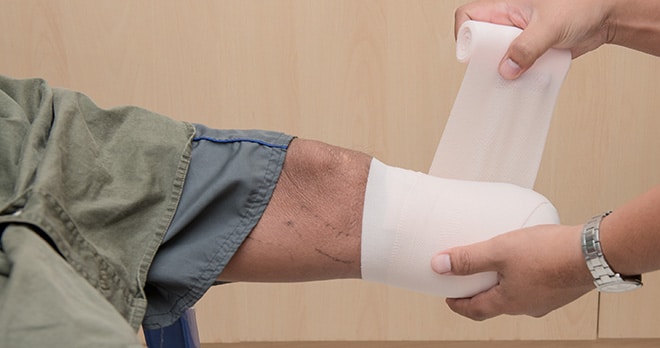Deep Vein Thrombosis (DVT) – what you need to know

Deep Vein Thrombosis (DVT) is a medical condition that occurs when a blood clot forms in a vein, usually the leg. Amputation is one of the serious complications that can occur if DVT is left untreated.
Signs and symptoms of DVT
The signs of DVT include:
- throbbing or cramping pain;
- swelling;
- warm skin around the painful area;
- red or darkened skin around the painful area;
- swollen veins that are hard or sore when you touch them.
These symptoms can also occur in the arm or stomach. Emergency medical attention should be sought if you have the above symptoms accompanied by breathlessness or chest pain.
DVT can be very serious. The blood clot can block blood flow to the leg, or it can break off and travel to the lungs, causing a pulmonary embolism. This can be life threatening and needs treatment straight away.
Who is more likely to get DVT?
DVT is more likely to happen if you are over 60, overweight, smoke, have had DVT before, take the contraceptive pill or HRT, have cancer or heart failure, or have varicose veins.
You can also be at risk of DVT in some temporary situations such as being confined to bed, going on a long journey, or if you are pregnant or dehydrated.
How is DVT diagnosed and how should doctors react?
If a doctor thinks you have DVT you should be referred to hospital within 24 hours for an ultrasound scan. This is to see whether blood is flowing normally through the vein. You may also have an X-ray of the vein where dye is injected to show where the blood clot is.
How do you treat DVT?
You can have an injection of anticoagulant (blood thinning) medicine, heparin, while you are waiting for an ultrasound scan to tell if you have a DVT.
After DVT is diagnosed, the main treatment is to take anticoagulant tablets for at least three months. If this medicine is not suitable, you may have a filter put into a large vein (the vena cava) which traps and stops a blood clot travelling to your heart and lungs. A newer form of treatment involves breaking up and sucking out the clot through a small tube in the vein.
When can DVT lead to amputation?
A delayed or missed diagnosis of DVT can sadly have serious and life-changing implications. When left untreated, a blood clot can block or restrict blood flow to the arteries in the limb making amputation a necessary and life-saving procedure.
At RWK Goodman, we support people who have been affected by delay in diagnosis and treatment of DVTs where symptoms are missed due to the negligence of the treating medical professionals. Compensation may be payable for this negligence and we can guide and support you through the legal process of claiming for an amputation.
We are keen to awareness of the complications involved in missed diagnosis of DVTs so that limb loss is prevented and symptoms are acted upon immediately.

Read our guide to amputations
If you have experienced limb loss, find out more about choosing the right prosthetic, the support available to you, and more in our guide.
Our guide covers what you need to know about types of amputation, rehabilitation, prosthetics, support networks and more.
If you have suffered limb loss as a result of negligent treatment or an accident, and want to find out whether you can make a claim for compensation, please contact our team today.
Call now
Read more on limb loss
Read more about amputation from our Info Hub
View more articles related to Amputation







